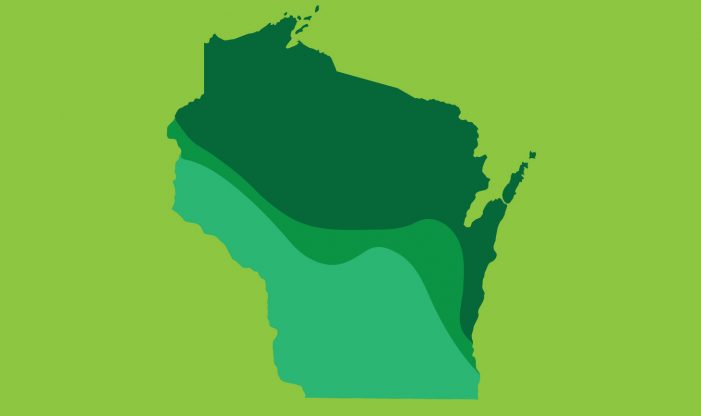If you’ve ever driven between northern and southern Wisconsin, you may have noticed a difference in the forests. It’s because of an interesting climatic feature which creates different ecological regions in the north and south. The area where the two regions meet is called the tension zone. This transitional zone stretches in an S-curve from northwestern Wisconsin to the southeastern part of the state. In these regions, you will find different species of plants, as well as animals, mostly because of climate and its effects on the land.
North of the Tension Zone
Northern Wisconsin is cooler than the south, and the species that live there are more like those you would find in Northern Minnesota, Northern Michigan, Ontario, and New England. The forest is a northern mixed forest, and it contains a number of plant communities. These include the boreal forest, northern hardwood swamp, northern mesic forest, and more. There are numerous differences between northern and southern tree species, notably, more conifers existing in the north.
Dominant tree species in both ecological regions tend to live together within group assemblages. In the northern mixed forest, white pine, tamarack, and spruce often appear together as an association, as do sugar maple, hemlock, and yellow birch. Though these trees may be found elsewhere in the state, when they are the dominant species in a region, they help determine the floristic composition of the landscape as well as influencing the habitat. Pine needles that fall to the ground and decompose, for example, make a different type of soil than is found in a southern deciduous forest.
In addition to a difference in plant species, animals vary between these ecological regions. Some of the animals living north of the tension zone include the black bear, snowshoe hare, and northern flying squirrel. Birds more prevalent in the north include Common Raven, Purple Finch, and Pileated Woodpecker.
South of the Tension Zone
The southern broadleaved forest exists south of the tension zone. The species here are adapted to climates similar to those in Indiana and Ohio. Plant communities include the southern mesic forest and conifer forest, like jack pine barrens. Also included are prairie, and oak savanna. The dominant tree associations are sugar maple, basswood, and white ash as well as groupings of oak and hickory. Wetland communities occur in both the north and the south.
A couple of the animals found only in the southern region of the state include the southern flying squirrel, and Blanchard’s cricket frog. Some of the breeding birds common in moist to dry southern forests are Downy Woodpecker, Blue Jay, Black-capped Chickadee, and Scarlet Tanager.
In the Tension Zone
Milwaukee County and the Center sit directly on the tension zone. Here, as well as at other locations on the tension zone, you will notice a mix of northern and southern species of trees and understory plants existing together. Sometimes, similar species from the different climatic regions mate and reproduce to form hybrid species. These are called ecotypes, and they are often more robust than the parent generation. Species in this category that are Important for land management are Canada goldenrod, switchgrass, and more.
Some features of the Center’s habitats relate to its location near Lake Michigan, which has an effect on climate. Average annual precipitation and temperature play a role in this, as they are different from inland areas. And though climate is very important in determining species composition in the ecological regions, there are other variables as well. Soil, precipitation, hydrology, invasive species, disturbance, and other factors play in role in what reproduces and survives, the keys to a species living in a natural area. These factors affect how we approach conservation and restoration of natural habitats at Schlitz Audubon.
The conservation team is restoring the Center to a mostly southern forest type. Interestingly, the Center’s habitat doesn’t have sugar maple as a dominant tree, as it often does in this region. Instead, it has red oak and basswood. It’s possibly because of the soil – heavy clay – that our forest makeup varies. Another factor in our dominant tree species varying for the region is because emerald ash borer is decimating ash trees.
Human Activity and Species Composition
Considering the restoration of habitats, Schlitz Audubon is experimenting with installing southern species, such as pawpaw, a small deciduous tree that produces large, yellowish-green to brown fruit, to adapt to the potential effects of climate change. Because of the many factors involved in species surviving at the Center, the conservation team is casting a wide net to see which ones are the most resilient.
Human activity also plays a large role in what species we will see within these regions. People heavily logged white pine in the north during the 1800s. It is still recovering and is less predominant than it would be had the forests remained intact. Also, because the southern growing season is longer, we see agricultural development in this climatic region. Urbanization is altering the landscape of the south as well.
The tension zone offers a wide-ranging observatory of species from two different ecological regions living together. At the Center, visitors will often see a very complex interaction of lake effects and climatic factors related to the tension zone. These have sway over which species survive and thrive.


